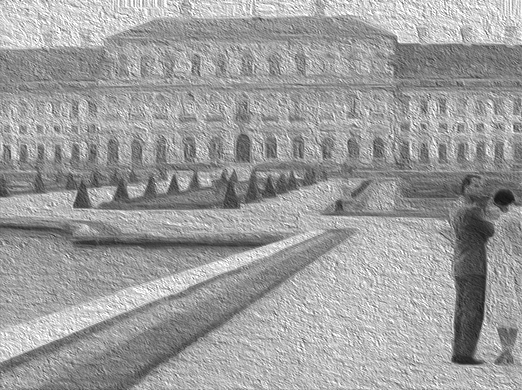
Last Year at Marienbad (L’année dernière à Marienbad, Alain Resnais, 1961) is the type of film that requires savouring after watching.
It’s really a great work. But watching it, especially for the first time, can make you feel exhausted. In this film, the female protagonist (Delphine Seyrig) comes to the Marienbad hotel with her husband. She meets the male protagonist (Giorgio Albertazzi) who wants to restart a romantic relationship with her. However, neither of them can tell how many of their memories about each other are illusions, or how much of what they see is real. Although it has been a long time since I heard the name of this film, I only had a little knowledge of European films back then. It’s completely unexpected that under this seemingly ordinary name, the film takes the style of fragmentation and stream of consciousness. If I had known this, I would have run to see it much earlier! Thanks to this film being recommended in my masters course, I had the opportunity to watch this film.
To understand this film, French philosopher Gilles Deleuze’s “time-image” film theory is very useful. In films that conform to this theoretical type, the protagonist of the film cannot distinguish right from wrong. In these films, the time flow of the past, present, and future, as well as time itself, is uncertain, and Last Year at Marienbad is a typical example of this. No matter the protagonist in a time-image film or the audience watching the film, no one can distinguish the past from the present; no one can distinguish among memory, fantasy, and reality; no one knows which plot or scene is the so-called reliable narrative. The female protagonist may die, or she may elope with the man finally. The content of the film may all be the fantasy in the male protagonist’s mind, but also may all be the fantasy in the female protagonist’s mind. The hotel, where the whole story happens, is a typical presentation of Deleuze’s “crystal-image”. All kinds of possibilities in the time, past and present, flow and solidification are presented together in this film, just like a crystal with various edges and planes.
Thanks to this film, for the first time I got a little understanding of the “Left Bank Group” – a group of French filmmakers in the 1950s and 60s – as well as the close relationship between this group’s films and French literature in film history. Their films were called by some people “author cinema”, but this “author” is different from the “auteur” in the French New Wave and the “author” in Andrew Sarris’s theory. This “author” means the writer of the story, while “auteur” means the director of the film (director being the main creator of the film). Unlike auteur cinema which emphasizes the status of directors, this group emphasises the importance of screenwriters and scripts, or alternatively, the importance of texts. The script of this film – written by Alain Robbe-Grillet – is as beautiful as the grand hotel, and it is the soul of this film. While I believe that this film may also be considered an auteur film, because it shows that Alain Resnais as the director plays the key role in the design of this film’s lens, setting, lighting, acting, and even costume. These all show the director’s intention to best present the stream of consciousness and the uncertainty of the world in the film. Resnais and this film were able to win so many awards, the main reason for which I think is the perfect combination of a great story text and a genius way to present it by a great director.
《去年在马里昂巴德》(L’année dernière à Marienbad, Alain Resnais, 1961) 是那种回味悠长、看完后需要歇歇脑子和精神的电影。电影真好,但看得也是真累。在这部电影中,随丈夫来到马里昂巴德酒店的女主人公遇到了想要与她重燃旧情的男主人公,然而二人谁也分不清关于彼此的回忆和眼前所见到底有多少是幻想,到底有几分是真实。虽说早就听闻此片大名,但在当时我对欧洲电影还几乎不了解,完全想不到在这个看似普通的名字下,居然是这种碎片化、意识流风格的内容。早知如此,我一定老早就去看了。感谢当时硕士专业课片单的推荐,才让我有了正式刷此片的机会。
想看懂这部电影可能需要了解德法国哲学家吉尔·勒兹(Gilles Deleuze)的“time-image”(时间-影像)电影理论:在符合这一理论类型的电影中,电影主人公分不清对错。同时,过去、现在与未来以及时间本身的流动都是不确定的,而这部《去年在马里昂巴德》就是德勒兹这一理论的典型。无论是电影中的主人公,还是在观看电影的观众我们,都分不清过去与现在,分不清记忆、幻想与现实,不知道哪一个段落或场景是所谓可靠的叙述。女主可能死了,也有可能最后成功与男主私奔了;全片可能全是男主的幻想,还有可能全是女主的幻想。整个大饭店就是德勒兹“crystal-image”(水晶-影像)的典型呈现:时间上的各种可能性、过去与现在、流动与凝固都同时呈现在其中,就像有着各种棱角和平面的水晶。
这部电影让我得以简单了解到法国“左岸派”(20世纪50到60年代出现在法国的一个电影导演集团,因成员都住在巴黎塞纳河的左岸而得名),了解到这一派电影与当时法国文学的密切关系,知道了他们的电影被一些人叫做“作家电影”(“author cinema”)。此“作家”(“author”)非彼“作者”(“auteur”),与安德鲁·萨里斯(Andrew Sarris)使用此词时的意义也不同。此处的“作家”指写作故事文本的人,而“作者”则是指在电影创作时做出主要影响的电影导演。与强调导演地位的“作者电影”不同,这一派强调编剧和剧本,也就是文本的前所未有的重要性。《去年在马里昂巴德》编剧阿兰·罗伯-格里耶(Alain Robbe-Grillet)的剧本就像片中的酒店一般,美轮美奂且是此片的灵魂所在。不过我也认为,此片或许也可算是作者电影,因为能明显看出阿伦·雷乃(Alain Resnais)为最好地呈现出电影中意识流和故事世界的不确定性设计的镜头、布局、打光、表演,甚至服化道要求等。当年雷乃能凭借此片获得颇多电影奖项,我想应该也主要归功于一个伟大的文本和一位伟大导演对其的天才运用。
Written for The Film Dispatch by Yudong Liu.

